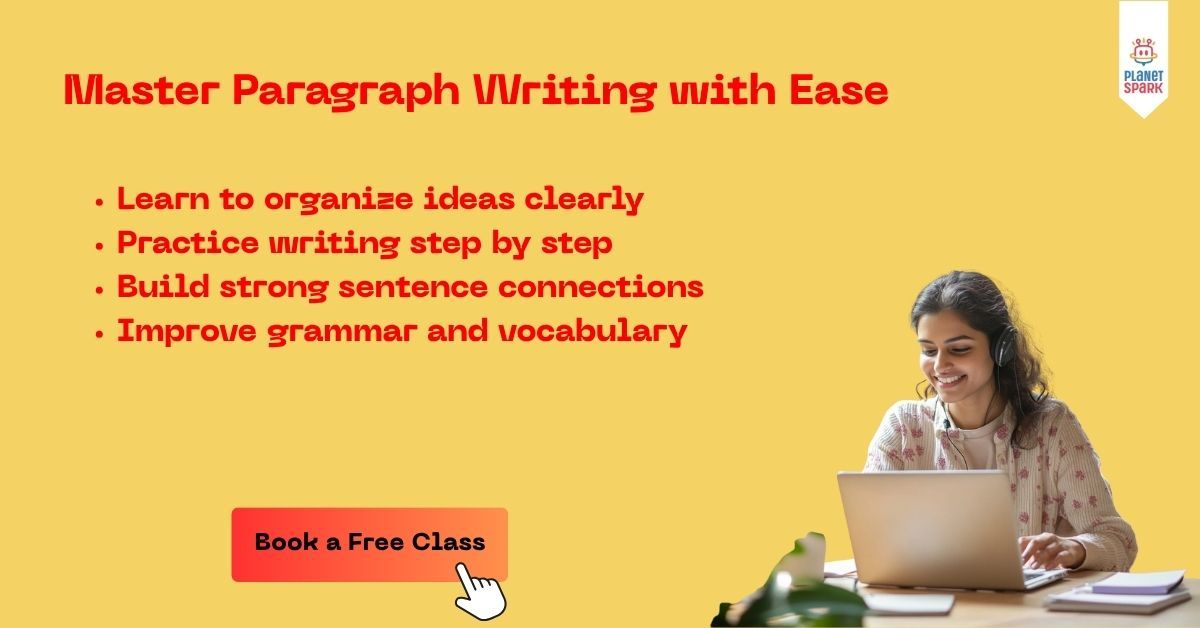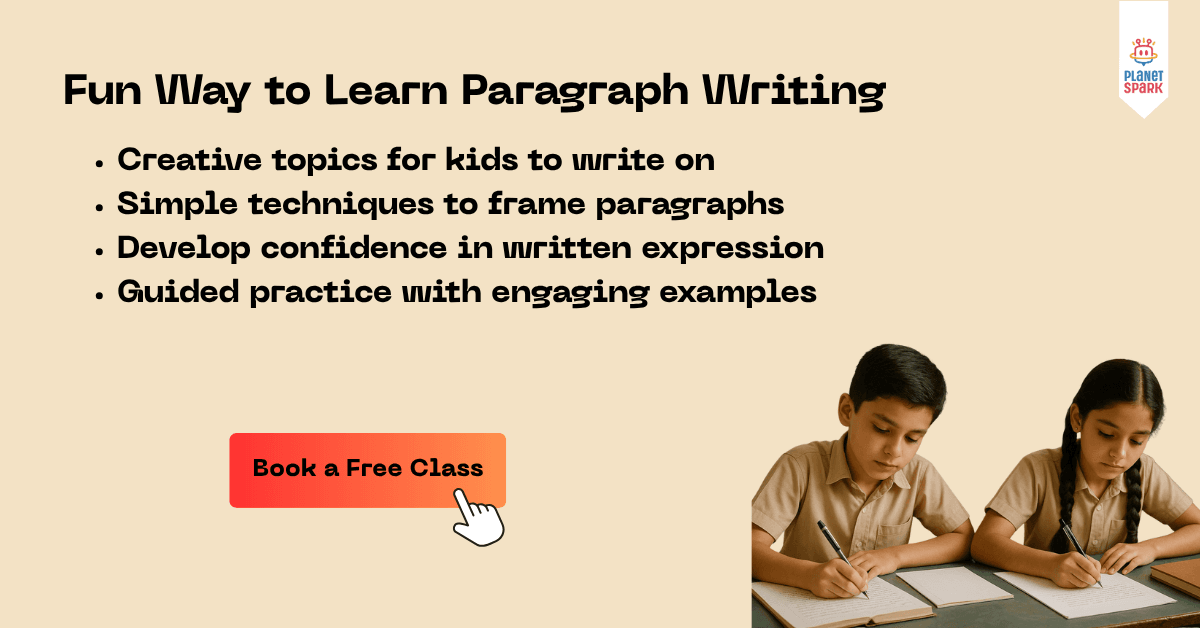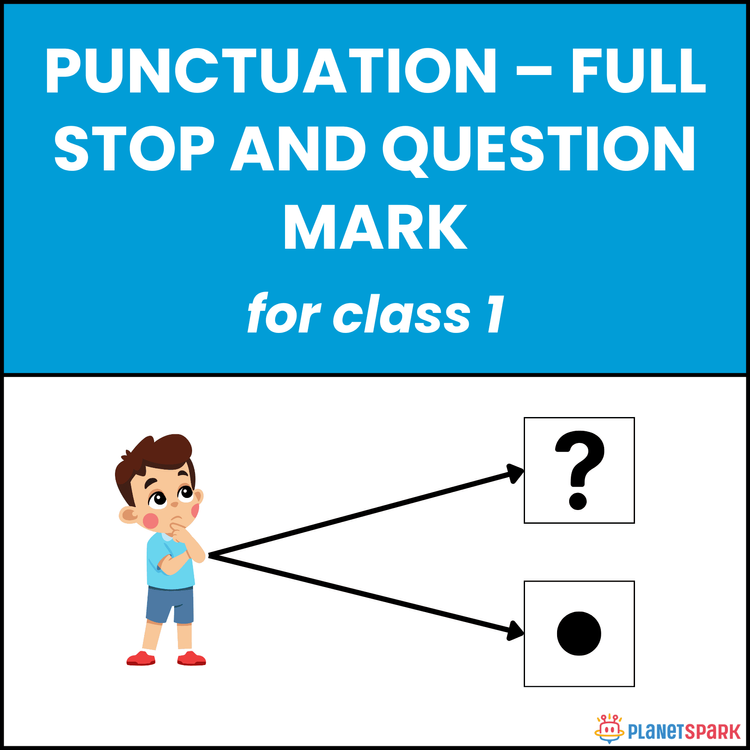Paragraph Writing: A Complete Guide for Students and Learners

Table of Contents
- What Is Paragraph Writing?
- Importance of Paragraph Writing
- Paragraph Writing Format
- Types of Paragraphs
- Popular Paragraph Writing Topics
- Tips for Effective Paragraph Writing
- Common Mistakes in Paragraph Writing
- Paragraph Writing for Exams
- Using Paragraph Writing in Real Life
- Advanced Paragraph Writing Techniques
- Paragraph Writing for Different Purposes
- How to Choose Paragraph Writing Topics
- Common Mistakes to Avoid in Paragraph Writing
- Practical Exercises for Paragraph Writing
- Paragraph Writing in Daily Life
- Benefits of Strong Paragraph Writing Skills
- Tips for Exam Success
- Conclusion
Paragraph writing is an essential skill in English that every learner must master. A well-written paragraph communicates ideas clearly, helps readers understand the content easily, and demonstrates your writing skills. Whether you are a student preparing for exams or someone learning English, mastering paragraph writing is crucial.
English paragraph writing is not just about putting words together. It’s about organizing your thoughts logically, using proper grammar, and maintaining a flow that keeps the reader engaged. From school essays to professional communication, strong paragraph writing skills make a significant difference.
In this guide, we will cover everything from paragraph writing topics to the paragraph writing format, along with tips, examples, and exercises to help you improve your writing.
What Is Paragraph Writing?
A paragraph is a group of related sentences that discuss a single topic. Paragraph writing involves putting together these sentences in a structured and meaningful way. Each paragraph should have a clear focus, coherence, and a smooth transition from one idea to another.
The paragraph writing format typically includes:
Topic Sentence: Introduces the main idea of the paragraph.
Supporting Sentences: Provides details, examples, or explanations related to the topic sentence.
Concluding Sentence: Summarizes the paragraph or provides a transition to the next paragraph.
Understanding this format is essential for both academic and creative writing. Whether you are writing a descriptive paragraph, a narrative, or an argumentative one, the basic structure remains the same.
Importance of Paragraph Writing
Paragraph writing is not only important for students but also for anyone who wants to improve communication skills. Here’s why it matters:
Enhances Clarity: Well-structured paragraphs make your ideas clear and easy to follow.
Improves Writing Skills: Regular practice helps develop vocabulary, grammar, and coherence.
Boosts Academic Performance: Essays, letters, and reports often depend on effective paragraph writing.
Strengthens Communication: Clear writing reflects clear thinking, which is valuable in professional and personal communication.
By focusing on English paragraph writing, learners can express their thoughts more effectively and impress teachers, peers, and readers alike.
Paragraph Writing Format
Understanding the paragraph writing format is key to writing effective paragraphs. Here’s a breakdown:
Topic Sentence:
The first sentence should clearly state the main idea. For example: “Healthy eating is essential for a balanced life.”Supporting Sentences:
Include facts, examples, or explanations that support the topic sentence. For example: “Eating fruits and vegetables provides essential vitamins and minerals that keep the body strong. Avoiding junk food reduces the risk of health problems like obesity and diabetes.”Concluding Sentence:
The last sentence summarizes the paragraph or connects it to the next idea. For example: “Therefore, maintaining a healthy diet is crucial for overall well-being.”
Using this format consistently will help you structure paragraphs logically and make your writing more impactful.
Types of Paragraphs
There are different types of paragraphs, each serving a unique purpose in writing. Understanding these types helps in selecting appropriate paragraph writing topics.
Descriptive Paragraphs:
These paragraphs describe a person, place, thing, or event in detail. They help the reader visualize the subject.
Example: “The garden was a riot of colors. Roses bloomed in red, yellow, and white, while tulips swayed gently in the morning breeze.”Narrative Paragraphs:
Narrative paragraphs tell a story or recount events. They usually follow a chronological order.
Example: “Last summer, I visited the mountains. The journey was tiring, but reaching the top was exhilarating.”Expository Paragraphs:
Expository paragraphs explain a concept or provide information. They are often used in academic writing.
Example: “Photosynthesis is the process by which plants make food using sunlight. Chlorophyll in leaves absorbs sunlight, which is then converted into energy.”Persuasive Paragraphs:
These paragraphs aim to convince the reader of a particular viewpoint.
Example: “School uniforms should be mandatory because they promote equality among students and reduce distractions in the classroom.”
By practicing different types of paragraphs, learners can handle a wide range of paragraph writing topics with confidence.

Popular Paragraph Writing Topics
Here are some common paragraph writing topics to practice:
My Favourite Hobby
The Importance of Cleanliness
A Memorable Day in My Life
The Benefits of Reading
My Favourite Festival
Importance of Time Management
Environmental Protection
My Best Friend
The Role of Technology in Education
How I Spend My Summer Vacation
Practicing with these topics helps students develop a strong foundation in English paragraph writing.
Tips for Effective Paragraph Writing
Understand the Topic: Read the topic carefully and identify the main idea.
Plan Before Writing: Outline the points you want to include in the paragraph.
Use Simple and Clear Language: Avoid complicated words and focus on clarity.
Maintain Coherence: Ensure sentences flow logically and connect with each other.
Check Grammar and Spelling: Proofread to avoid errors and enhance readability.
Practice Regularly: The more you write, the better you become at paragraph writing.
Following these tips will improve your ability to write structured and compelling paragraphs.
Common Mistakes in Paragraph Writing
Even experienced writers can make mistakes. Here are some common errors to avoid:
Lack of Focus: Straying from the main idea can confuse the reader.
Poor Structure: Missing topic or concluding sentences weaken the paragraph.
Repetition: Using the same words or ideas repeatedly reduces interest.
Grammar Errors: Mistakes in punctuation, tense, or sentence structure affect readability.
Overcomplicating Sentences: Long and complex sentences can be hard to understand.
By being aware of these mistakes, learners can produce high-quality paragraphs.
Paragraph Writing for Exams
Many exams, including school tests and competitive exams, assess paragraph writing skills. Key points to remember include:
Stick to the paragraph writing format.
Choose relevant paragraph writing topics.
Express ideas clearly and concisely.
Check for grammar, spelling, and punctuation.
Regular practice with exam-oriented exercises ensures success in English paragraph writing tasks.

Using Paragraph Writing in Real Life
Paragraph writing is not limited to academics. It is useful in:
Emails and Letters: Clear paragraphs help convey messages effectively.
Reports and Articles: Well-structured paragraphs improve readability and professionalism.
Creative Writing: Stories, blogs, and essays rely on engaging paragraphs.
Presentations: Paragraphs can help organize thoughts and content for speeches.
Mastering paragraph writing improves both written and spoken communication.
Advanced Paragraph Writing Techniques
Once you are familiar with the basics, you can move on to advanced techniques to make your paragraphs more effective and engaging. These include:
Using Transitional Words: Words like however, moreover, consequently, and therefore help connect ideas smoothly and maintain a logical flow.
Varying Sentence Length: Mix short and long sentences to create rhythm and maintain reader interest.
Incorporating Examples: Support your points with examples, statistics, or anecdotes to make your paragraph stronger.
Using Active Voice: Writing in active voice makes sentences more direct and powerful.
Eliminating Redundancy: Avoid repeating the same idea or words unnecessarily to keep the paragraph concise.
These techniques enhance the quality of English paragraph writing and make your work more professional and persuasive.
Paragraph Writing for Different Purposes
Paragraphs can serve different purposes depending on the context. Understanding the purpose helps in choosing the right style, tone, and content.
Academic Paragraphs: Used in essays, research papers, and reports. They must be formal, structured, and evidence-based.
Creative Paragraphs: Used in stories, blogs, and journals. They can be descriptive, imaginative, and expressive.
Business Paragraphs: Used in emails, proposals, and presentations. They should be concise, clear, and goal-oriented.
Persuasive Paragraphs: Aim to convince readers of a point of view. They often appear in opinion pieces, letters, or debates.
Reflective Paragraphs: Used to express personal thoughts, experiences, or learning reflections.
By mastering various styles, you can confidently write for any scenario while maintaining clarity and impact.
How to Choose Paragraph Writing Topics
Selecting the right paragraph writing topics is important for practice and exams. Consider these tips:
Know Your Audience: Tailor your topic to suit readers’ interests or exam requirements.
Choose a Topic You Understand: It’s easier to write about something you are familiar with.
Be Specific: Avoid broad topics; narrow down to a clear focus.
Brainstorm Ideas: Write down points before starting to structure your paragraph.
Practice Variety: Try different topics like festivals, hobbies, the environment, or personal experiences to gain versatility.
Practicing multiple topics prepares you for academic assignments, competitive exams, and creative writing tasks. Struggling with grammar rules? PlanetSpark makes English grammar simple and fun with interactive lessons, real-time practice, and expert guidance.
Common Mistakes to Avoid in Paragraph Writing
Even skilled writers make mistakes. Being aware of these can improve your work significantly:
Off-topic Sentences: Ensure every sentence supports the main idea.
Weak Opening Sentences: Start with a clear topic sentence to grab attention.
Poor Transitions: Abrupt jumps between sentences make reading difficult.
Inconsistent Tense: Stick to past, present, or future tense consistently.
Lack of Conclusion: Concluding sentences help summarize and close the paragraph effectively.
By avoiding these errors, your English paragraph writing becomes more coherent, persuasive, and professional.
Practical Exercises for Paragraph Writing
Practicing regularly improves fluency and confidence. Here are some exercises:
Picture Description: Look at an image and write a descriptive paragraph. Focus on details, colors, and emotions.
Story Completion: Start a story and write a paragraph to continue it logically.
Opinion Writing: Pick a current event and write a paragraph expressing your opinion with reasons.
Paragraph Expansion: Take a simple sentence and expand it into a full paragraph with supporting details.
Peer Review: Exchange paragraphs with friends or peers for feedback and improvement.
These exercises develop your ability to think creatively, structure thoughts, and write clearly.
Paragraph Writing in Daily Life
Paragraph writing isn’t just for school- it’s essential in daily communication:
Emails and Letters: Structuring your messages in paragraphs ensures clarity.
Social Media Posts: Clear, concise paragraphs make posts engaging and readable.
Reports and Presentations: Organized paragraphs convey information effectively.
Journals and Diaries: Reflective writing enhances self-expression.
Storytelling: Paragraphs make narratives more engaging and easier to follow.
Mastering paragraph writing equips you with skills useful in academics, professional life, and creative pursuits.
Benefits of Strong Paragraph Writing Skills
Strong paragraph writing skills offer multiple benefits:
Improved Academic Performance: Essays, reports, and assignments become structured and impactful.
Enhanced Communication: Clear writing reflects clear thinking, making interactions more effective.
Creativity Development: Writing regularly stimulates imagination and innovation.
Confidence Boost: The Ability to express ideas clearly increases self-confidence.
Career Advantage: Effective writing skills are valued in almost every profession.
By focusing on English paragraph writing, learners can unlock academic, professional, and personal growth opportunities.
Tips for Exam Success
Read the prompt carefully and identify the main topic.
Plan your paragraph by jotting down key points.
Stick to the paragraph writing format for clarity.
Avoid unnecessary repetition or digression.
Review your paragraph for grammar, spelling, and punctuation.
These strategies help students tackle any paragraph writing topics confidently.
Conclusion
Paragraph writing is a fundamental skill that enhances communication, clarity, and creativity. By understanding the paragraph writing format, practicing various types, and exploring different paragraph writing topics, anyone can become a confident and effective writer.
Frequently Asked Questions
Paragraph writing is the skill of expressing ideas in a group of connected sentences that revolve around a single main idea. It helps in organizing thoughts clearly.
A paragraph usually follows this format: Topic sentence → Supporting details → Concluding sentence. This structure makes the writing clear and logical.
A good paragraph generally has 5–8 sentences, but the length can vary depending on the topic and purpose.
Common topics include My Best Friend, My School, Importance of Reading, Discipline, Festivals, and Technology. These help students practice expressing their thoughts.
You can improve by reading more, practicing regularly, using simple language, sticking to one idea per paragraph, and revising your work for clarity.
Download Free Worksheets
Personalized Communication Report
Record a video to get a AI generated personalized communication report for your child

Hi There, want to try these
tips for your child with
LIVE with our expert coach?
Let's check your child's
English fluency

